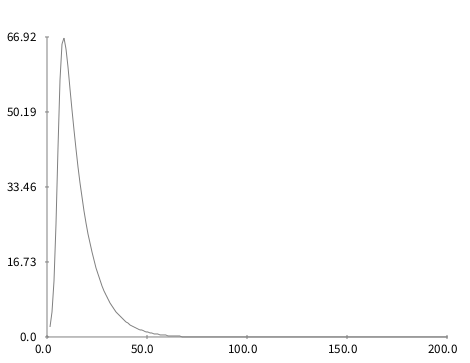-
-
Notifications
You must be signed in to change notification settings - Fork 41
Quick start to ODE
The following code shows how to obtain the numerical solution of a simple one-dimensional ODE. Note the configuration of the stepper type showing the flexibility of the library. We solve the simple ODE x' = 3/(2t^2) + x/(2t) with initial condition x(1) = 0 and step size 0.1.
|dt system stepper solver|
dt := 0.1.
system := PMExplicitSystem block: [:x :t | 3.0 / (2.0 * t * t) + (x / (2.0 * t))].
stepper := PMRungeKuttaStepper onSystem: system.
solver := (PMExplicitSolver new) stepper: stepper; system: system; dt: dt.
solver solve: system startState: 0 startTime: 1 endTime: 10Every time, you need to solve an ODE, you will need to setup three different object: a system that represent an or a set of ODEs, a stepper that deals with the method that will be used to solve your ODE and finally a solver.
With the PMExplicitSystem block you can represent as a function of 2 arguments (t and x), the rhs (right hand side) of the differential equation: dx/dt = f(x,t).
Let's try to do plot the behavior of an compartimental model in epidemiology like SIR:
|solver state system dt beta gamma values stepper diag|
dt := 1.0.
beta := 0.01.
gamma := 0.1.
system := PMExplicitSystem block: [ :x :t| |c|
c := Array new: 3.
c at: 1 put: (beta negated) * (x at: 1) * (x at: 2).
c at: 2 put: (beta * (x at: 1) * (x at: 2)) - (gamma * (x at: 2)).
c at: 3 put: gamma * (x at: 2).
c
].
stepper := PMRungeKuttaStepper onSystem: system.
solver := (PMExplicitSolver new) stepper: stepper; system: system; dt: dt.
state := #(99 1 0).
values := (0.0 to: 200.0 by: dt) collect: [ :t| state := stepper doStep: state
time: t stepSize: dt ].Using Graph-ET for visualising the infectious evolutionary diagram:
For only one diagram:
diag := GETDiagramBuilder new.
diag lineDiagram
models: (1 to: 200 by: 1);
y: [ :x| (values at: x) at: 2 ];
regularAxis.
diag open.For a composite diagram of S (blue), I (red) and R (green)
|colors|
diag := OrderedCollection new.
colors := Array with: Color blue with: Color red with: Color green.
1 to: 3 do: [ :i|
diag add:
((GETLineDiagram new)
models: (1 to: 200 by: 1);
y: [ :x| (values at: x) at: i ];
color: (colors at: i))
].
builder := (GETDiagramBuilder new).
builder compositeDiagram
xAxisLabel: 'Time in days';
yAxisLabel: 'Number of Individuals';
regularAxis;
diagrams: diag.
builder open.Let's try to implement the Lorenz attractor as the a set of 3 differential equations, that we will solved with a Runge-Kutta solver:
| solver stepper system dt sigma r b state values diag|
sigma := 10.0.
r := 28.
b := 8.0/3.0.
dt := 0.01.
system := ExplicitSystem
block: [:x :t | | c |
c:= Array new: 3.
c at: 1 put: sigma * ((x at: 2) - (x at: 1)).
c at: 2 put: r * (x at: 1) - (x at: 2) - ((x at: 1) * (x at: 3)).
c at: 3 put: (b negated * (x at: 3) + ((x at: 1) * (x at: 2))).
c].
stepper := RungeKuttaStepper onSystem: system.
solver := (ExplicitSolver new) stepper: stepper; system: system; dt: dt.
state := #(10.0 10.0 10.0).
values := (0.0 to: 100.0 by: dt) collect:[:t |
state := stepper doStep: state time: t stepSize: dt.
state].We can try to visualize the result by using GraphET:
diag := GETDiagramBuilder new.
(diag scatterplot)
models: values;
x: [: v | v at: 1 ];
y: [: v | v at: 2 ];
regularAxis;
dotSize: 1.
diag openAs there are different case what value to write for system, stepper and solver here you have a hint:
(Pay attentions: for first 3 methods you should write your order of method like thisAB3Stepper. )
| Methods | System | Stepper | Solver | Comment |
|---|---|---|---|---|
Adams - Bashforth method of order n=2,3,4
|
ExplicitSystem | ABnStepper |
ABnSolver |
|
Adams - Moulton method of order n=3,4
|
ImplicitSystem | AMnStepper |
AMnSolver |
|
Backward differentiation formulas method of order n=2,3,4
|
ImplicitSystem | BDFnStepper |
BDFnSolver |
|
| Beckward Euler method | ImplicitSystem | ImplicitStepper | ImplicitSolver | |
| Euler method | ExplicitSystem | ExplicitStepper | ExplicitSolver | |
| Heun method | ExplicitSystem | HeunStepper | ExplicitSolver | Heun's method may refer to the improved or modified Euler's method (that is, the explicit trapezoidal rule), or a similar two-stage Runge-Kutta method. |
| Implicit midpoint method | ImplicitSystem | ImplicitMidpointStepper | ImplicitMidpointSolver | |
| Midpoint method | ExplicitSystem | MidpointStepper | ExplicitSolver | |
| Runge-Kutta method (order 4) | ExplicitSystem | RungeKuttaStepper | ExplicitSolver | |
| Trapezoidal rule | ImplicitSystem | TrapezoidStepper | ImplicitSolver | It is Adams - Moulton method of order 2 |





